NCERT Solutions for Class 12 Macro Economics Chapter-7 Excess Demand and Deficient Demand
MORE QUESTIONS SOLVED
I.Very Short Answer Type Questions (1 Mark)
Question 1. What is meant by excess demand in macroeconomics? [CBSE 2009]
Answer: When in an economy aggregate demand exceeds “aggregate supply at full employment level”, the demand is said to be an excess demand.
Question 2. Define inflationary gap. [CBSE 2008]
Answer: When in an economy aggregate demand exceeds “aggregate supply at full employment level”, the demand is said to be an excess demand and the gap is called inflationary gap.
Question 3. Give the meaning of deficient demand.
Answer: When in an economy aggregate demand falls short of aggregate supply at full employment level, the demand is said to be as deficient demand.
Question 4. Define deflationary gap. [CBSE 2008]
OR
Give the meaning of deflationary gap. [CBSE 2010]
Answer:” When in an economy aggregate demand falls short of aggregate supply at full employment level, the demand is said to be deficient demand and the gap is called deflationary gap.
Question 5. State two measures by which a central bank can attempt to reduce the inflationary gap.
Answer:
- Increase in cash reserve ratio.
- Increase in marginal requirement.
Question 6. What is the impact of increase in margin requirements?
Answer: Increase in margin requirements discourages borrowings and decreases the aggregate demand.
Question 7. Give the meaning of full employment.[CBSE 2008]
Answer: Full employment equilibrium refers to the situation where aggregate demand = aggregate supply and all those who are able to work and willing to work (at the existing wage rate) are getting work.
Question 8. Give the meaning of involuntary unemployment.[CBSE 2008, 09, Sample Paper 2010]
Answer: Involuntary unemployment refers to a situation in which all able and willing persons to work at existing wage-rate do not find work. They are rendered unemployed against their wish. Hence, it is termed as involuntary unemployment.
Question 9. Is it necessary that equality between AD and AS is established at the full employment level?
Answer: No, it is not necessary that full employment occurs when AD = AS. Equilibrium can be achieved at full employment level, under employment level or at over full employment level.
Question 10. What is meant by full employment equilibrium?
Answer: Full employment equilibrium refers to a situation when equilibrium is attained i.e., aggregate demand is equal to aggregate supply at full employment level.
Question 11. What is underemployment equilibrium?[CBSE 2008]
Answer: Underemployment equilibrium refers to a situation when equilibrium is attained i.e., aggregate demand is equal to aggregate supply below full employment level or when resources are not fully employed.
Question 12. What is the meaning of over full employment equilibrium?
Answer: Over full employment level refers to a situation when equilibrium is attained, i.e., aggregate demand is equal to aggregate supply beyond the full employment level.
II. Multiple Choice Questions (1 Mark)
Question 1. Name the situation under which aggregate demand exceeds aggregate supply at the full employment level,
(a) Excess demand (b) Excess supply
(c) Deflationary gap (d) None of them
Answer: (a)
Question 2. Name the situation under which aggregate demand falls short of aggregate supply
at full employment level.
(a) Excess demand (b) Excess supply
(c) Inflationary gap (d) None of them
Answer: (b)
Question 3. What is the impact of deficient demand on production and employment?
(a) Increase
(b) Decrease
(c) Remains constant
(d) None of them
Answer: (b)
Question 4. The various fiscal policy measures that can increase aggregate demand and thus, control the problem of deficient demand are:
(a) Increasing the level of government expenditure.
(b) Reduction in the level of taxes.
(c) A mix of increasing government expenditure and decreasing the rate of taxes
(d) All of them
Answer: (d)
Question 5. The various fiscal policy measures that can decrease aggregate demand, and thus, control the problem of excess demand are:
(a) Reducing the level of government expenditure.
(fa) Increasing the amount of taxes.
(c) A mix of reducing government expenditure and increasing tax rates
(d) All of them
Answer: (d)
Question 6. The various monetary policy measures that can increase aggregate demand, and thus, control the problem of deficient demand are:
(a) Reduction in bank rate.
(b) Purchase of government securities in the open market by the central bank.
(c) Reduction in CRR and SLR.
(d) All of them
Answer: (d)
Question 7. The various monetary policy measures that can decrease aggregate demand, and thus, control the problem of excess demand are:
(a) Increase in the bank rate.
(b) Sale of government securities in the open market by the central bank.
(c) Raising CRR and SLR.
(d) All of them
Answer: (d)
III. Short Answer Type Questions (3-4 Marks)
Question 1. What are the reasons or causes for excess demand?
Answer: The main reasons for excess demand are apparently the increase in the following components of aggregate demand:
- Increase in household consumption demand due to rise in propensity to consume.
- Increase in private investment demand because of rise in credit facilities.
- Increase in public (government) expenditure.
- Increase in export demand.
- Increase in money supply or increase in disposable income.
Question 2. What are impacts or effects of excess demand on price, output, employment?
Answer:
- Effect on General Price Level: Excess demand gives a rise to general price level because it arises when aggregate demand is more than aggregate supply at a full employment level. There is inflation in economy showing inflationary gap.
- Effect on Output: Excess demand has no effect on the level of output. Economy is at full employment level and there is no idle capacity in the economy. Hence output can’t increase.
- Effect on Employment: There will be no change in the level of employment also. The economy is already operating at full employment equilibrium, and hence there is no unemployment.
Question 3. What are the reasons or causes for deficient demand?
Answer: The main reasons for deficient demand are apparently the decrease in four components of aggregate demand:
- Decrease in household consumption demand due to fall in propensity to consume.
- Decrease in private investment demand because of fall in credit facilities.
- Decrease in public (government) expenditure.
- Decrease in export demand.
- Decrease in money supply or decrease in disposable income.
Question 4. What are the impacts or effects of deficient demand on price (output) employment?
Answer:
- Effect on General Price Level:Deficient demand causes the general price level to fall because it arises when aggregate demand is less than aggregate supply at full employment level. There is deflation in an economy showing deflationary gap.
- Effect on Employment: Due to deficient demand, investment level is reduced, which causes involuntary unemployment in the economy due to fall in the planned output.
- Effect on Output: Low level of investment and employment implies low level of output.
Question 5. Explain the role of Government expenditure and Open Market Operation in reducing AD/excess demand. [CBSE 2004C, 06, CBSE 2011; A 11]
Answer: (a) Government Expenditure:
- Government has to invest huge amount on public works like roads, buildings, irrigation works, etc.
- During inflation, government should curtail (reduce) its expenditure on public works like roads, buildings, irrigation works thereby reducing the money income of the people and their demand for goods and services.
(b) Open Market Operation:
- It consists of buying and selling of government securities and bonds in the open market by central bank.
- In a situation of excess demand leading to inflation, central bank sells government securities and bonds to commercial bank. With the sale of these securities, the power of commercial bank of giving loans decreases, which will control excess demand.
Question 6. Differentiate between full employment and underemployment equilibrium.
Answer:
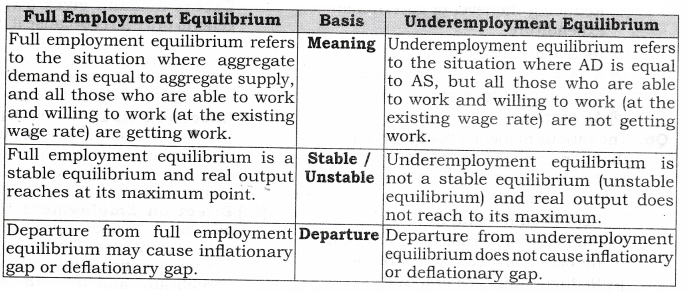
Question 7. What is meant by Margin Requirement? How does the Central Bank use this measure to control deflationary conditions in an economy?[CBSE Sample Paper 2016]
Answer:
- Business and traders get credit from commercial bank against the security of their goods. Bank never gives credit equal to the full value of the security. It always pays less value
than the security. - So, the difference between the value of security and value of loan is called marginal requirement.
- In a situation of deficient demand leading to deflation, central bank decreases marginal requirements. This encourages borrowing because it makes people get more credit against their securities.
IV. True Or False
Are the following statements true or false? Give reasons.
Question 1. To control deflation the central bank should increase the bank rate.
Answer: False. The central bank should decrease the bank rate in order to control deflation.
Question 2. Purchase of government securities by the central bank in the open market is an appropriate policy to check depression in the economy.
Answer: True. To check depression the central bank should purchase government securities from the open market, so as to increase the availability of credit in the economy.
Question 3. To correct the deflationary gap, availability of credit should be increased.
Answer: True. Availability of credit should be increased to raise the level of aggregate demand.
Question 4. Fiscal policy has a direct effect on producing sector of the economy.
Answer: False. Fiscal policy has a direct effect on all the sectors of the economy.
Question 5. Equilibrium below full employment level does not lead to fall in output level.
Answer: False. Equilibrium below the full employment level leads to deflation, which causes low level of investment and employment implies low level of output.
Note: As per CBSE guidelines, no marks will be given if reason to the answer is not explained.
V. Long Answer Type Questions (6 Marks)
Question 1. Explain the concept of underemployment equilibrium with the help of a diagram. Show on the same diagram the additional investment expenditure required to reach full employment equilibrium.[CBSE 2004] OR
Explain the meaning of underemployment equilibrium. Explain two measures by which full employment equilibrium can be reached. [A/2013 (Set-7)]
Answer:
- Underemployment equilibrium refers to a situation when equilibrium is attained i.e., aggregate demand is equal to aggregate supply below full employment level or when resources are not fully employed.
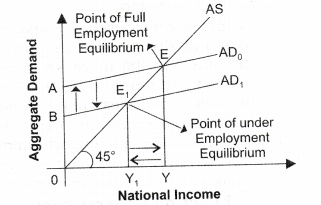
- In the above diagram full employment level of national income is attained at point E, but due to deficient demand, aggregate demand shifts downward from AD to AD0 and hew equilibrium is attained at point E1; which is below full employment level. The aggregate demand shifts downward because of the following reasons.
(i) Decrease in household consumption demand due to fall in propensity to consume.
(ii) Decrease in private investment demand because of fall in credit facilities.
(iii) Decrease in public (government) expenditure.
(iv) Decrease in export demand.
(v) Decrease in money supply or decrease in disposable income. - In order to achieve full employment equilibrium deficiency of demand must be corrected through additional investment expenditure. In the diagram deficiency of AD = AB. Thus, AB amount of additional investment is required to reach the level of full employment.
Question 2. Differentiate between inflationary gap and deflationary gap. Show deflationary gap on a diagram. Can this gap exist at equilibrium level? Explain. [CBSE, 2004, AI 2013]
Answer:
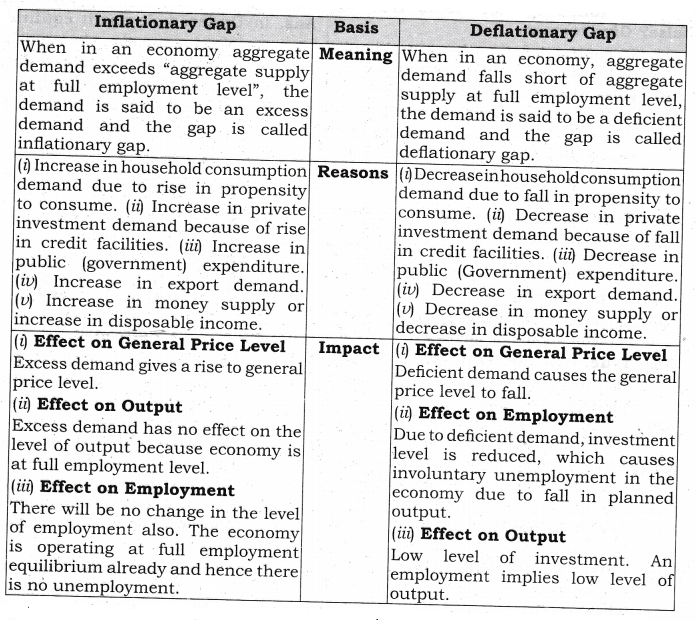
Yes, deflationary gap can exist at equilibrium level of income. In the below figure equilibrium is attained at a equilibrium point E,, when deflationary gap is EB.
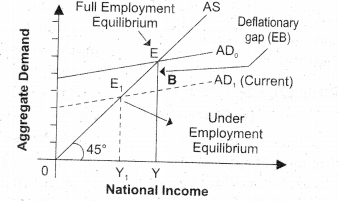
Question 3. Explain the concept of Inflationary Gap. Explain the role of Repo Rate in reducing this gap. [CBSE 2015] Or
What is meant by Repo Rate? How does the Central Bank use this measure to control inflationary conditions in an economy? [CBSE Sample Paper 2016]
Answer:
- Inflationary gap is the gap showing excess of current aggregate demand over ‘aggregate supply at the level of full employment’. It is called inflationary because it leads to inflation (continuous rise in prices).
- It can be explained with the help of following diagram:
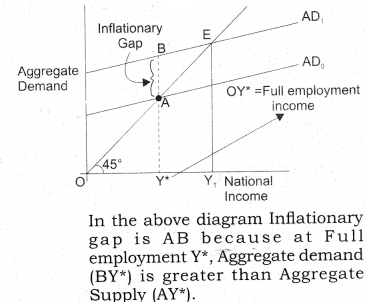
- (i) Repo rate is the. rate at which commercial bank borrow money from the central bank for short period by selling their financial securities to the central bank.
(ii) These securities are pledged as a security for the loans.
(iii) It is called Repurchase rate as this involves commercial bank selling securities to RBI to borrow the money with an agreement to repurchase them at a later date and at a predetermined price.
(iv) So, keeping securities and borrowing is repo rate.
(v) In a situation of excess demand leading to inflation,
• Central bank raises repo rate that discourages commercial banks in borrowing from central bank as it will increase the cost of borrowing of commercial bank.
• It forces the commercial banks to increase their lending rates, which discourages borrowers from taking loans, which discourages investment.
• Again high rate of interest induces households to increase their savings by restricting expenditure on consumption.
• Thus, expenditure on investment and consumption is reduced, which will control the excess demand.
Question 4. Explain the concept of Deflationary Gap and the role of ‘Open Market Operations’ in reducing this gap.[CBSE 2015]
Answer:
- Deflationary gap is the gap showing deficient of current aggregate demand over ‘aggregate supply at the level of full employment. It is called deflationary because it leads to deflation (continuous fall in prices).
- It can be explained with the help of following diagram:
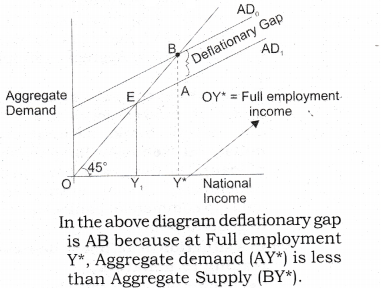
- (i) Open Market Operation consists of buying and selling of government securities and bonds in the open market by central bank.
(ii) In a situation of deficient demand leading to deflation,central bank purchases government securities and bonds from commercial bank. With the purchase of these securities, the power of commercial bank of giving loans increases, which will control deficient demand.
Question 5. What is ‘deficient demand’? Explain the role of ‘Bank Rate’ in removing it.[AI 2015]
Answer:
- When in an economy, aggregate demand falls short of aggregate supply at full employment level, the demand is said to be a deficient demand.
- It can be explained with the help of following diagram:
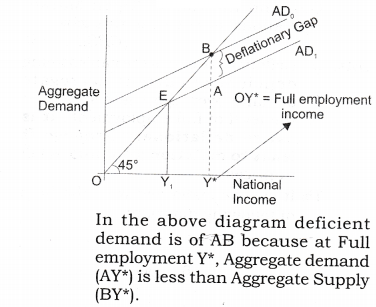
- (i) Bank rate is the rate of interest at which central bank lends to commercial banks without any collateral (security for purpose of loan). The thing, which has to be remembered, is that central bank lends to commercial banks and not to general public.
(ii) In a situation of deficient demand leading to deflation,
• Central bank decreases bank rate that encourages commercial banks in borrowing from central bank as it will decrease the cost of borrowing of commercial bank.
• Decrease in bank rate makes commercial bank to decrease their lending rates, which encourages borrowers from taking loans, which encourages investment.
• Again low rate of interest induces households to decrease their savings by increasing expenditure on consumption.
• Thus, expenditure on investment and consumption increase, which will control the deficient demand.
Question 6. What is ‘excess demand’? Explain the role of ‘Reverse Repo Rate’ in removing it. [AI 2015]
Answer:
- When in an economy, aggregate demand exceeds “aggregate supply at full employment level”, the demand is said to be an excess demand.
- It can be explained with the help of following diagram:
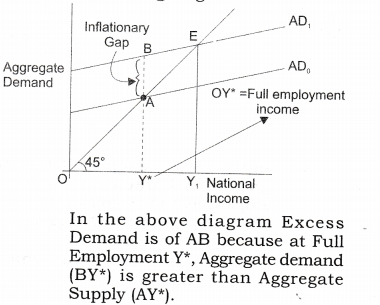
- (i) Reverse Repo Rate is the rate at which the central bank (RBI) borrows money from commercial bank.
(ii) In a situation of excess demand leading to inflation, Reverse repo rate is increased, it encourages the commercial bank to park their funds with the central bank to earn higher return on idle cash. It decreases the lending capability of commercial banks, which controls excess demand.
VI. Higher Order Thinking Skills
Question 1. It is necessary that the equilibrium level of national income is always at a full employment level. Explain this statement. [6 Marks]
Answer: It is not necessary because equilibrium level of national income can be attained:
- At full employment level.
- Over full employment level, or above the full employment level (in case of excess demand).
- Underemployment level or below full employment level (in case of deficient demand).
- At full employment equilibrium level: Full employment equilibrium refers to a situation when equilibrium is attained, i.e., aggregate demand is equal to aggregate supply at full employment level.
In the given diagram, full employment level of national income and equilibrium level is attained at Point E. So, equilibrium is possible at full employment level.
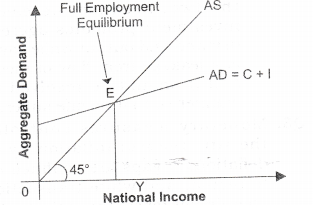
- Over full employment level or Above the full employment level: Over full employment level refers to a situation when equilibrium is attained, i.e., aggregate demand is equal to aggregate supply beyond full employment level.
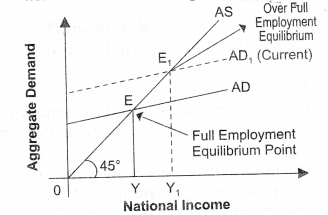
In the given diagram full employment level of national income is attained at point E, but due to the excess demand, the aggregate demand shifts upward from AD0 to AD0 Due to shift in AD the new equilibrium is attained at point E1 which is above the equilibrium level. - Underemployment equilibrium: It refers to a situation when equilibrium is attained, i.e., aggregate demand is equal to aggregate supply below the full employment level or when resources are not fully employed.
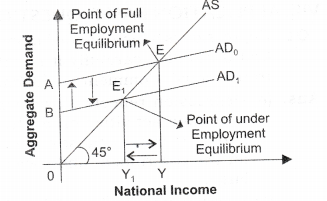
In the above diagram full employment level of national income is attained at point E but due to deficient demand, aggregate demand shifts downward from AD0 to AD1 and new equilibrium is attained at point Et, which is below full employment level.
VII.Value Based Questions
Question 1. In Indian market, money supply is the reason of rising price level. Explain any one measure of central bank to control money supply? [3 Marks]
Answer: Explain any one reason:
- Bank rate
- Cash reserve ratio (CRR)
- Statutory liquidity ratio (SLR)
Value : Critical thinking
Question 2. Excess money supply is necessary for rapid economic development but it creates inflationary situation. Write any two fiscal measures to control inflationary situation. [3 Marks]
Answer: Fiscal Measures:
- Increase in tax rates (Explain)
- Reduce public expenditure (Explain)
Value : Critical thinking
Question 3. In India unemployment is a major problem, If aggregate demand is equal to aggregate supply, can it be called a situation of equilibrium? [ 1 Mark]
Answer: Yes, but it will be underemployment equilibrium, and there exists a voluntary unemployment in an economy.
Value : Problem solving
Question 4. Increase in money supply is an effective measure to control economic depression, but it creates the burden of borrowing on economy. Explain any two measures by which economic depression can be controlled even in the situation of increase in money supply. [3 Marks]
Answer: (a) Decrease in bank rate. (Explain) (b) Decrease in statutory liquidity ratio (SLR) (Explain).
Value : Critical thinking
VIII.Applications Based Questions
Question 1. Depression is a high-handed monster, and if handled carefully it is not so troublesome. Comment. [3 Marks]
Answer:
- Depression reflects slowdown of economic activities on all fronts and therefore is a cause of concern for the government and society at large.
- However, if tackled carefully taking appropriate monetary and fiscal measures, it may prove useful.
- As it has happened in 1929 in America, and also in the years from 2008 to 2012 in the context of slow down of the Indian economy.
Question 2. Small investors (such as households) deposit their savings to sustain their livelihood present and futurd, but government reduces interest rate for boosting economy. This is inequitable. How? [3-4 Marks]
Answer:
- Households mobilize their savings and deposits it in the banks to earn
interest for meeting their current and future needs. - If there is a fall in the interest rate, they get less interest, and, hence, find it difficult to sustain their livelihood.
- But, on the other hand, RBI thinks of reducing interest rate for boosting the climate of investment.
- There is a contradiction between the two, because increase in investment promotes aggregate demand and output while savings is a leakage from flow of income, and it should be resolved in a manner so that no one suffers.
Question 3. Monetary measures controlling the situations of inflationary and deflationary gaps are confined only to regular and white transactions. They do not reflect the real situation. Comment. [3 Marks]
Answer: In India, in unorganized sectors.such as small industries and agriculture, there are vast activities relating to aggregate demand and aggregate supply which are not reflected while assessing the gaps. It is because of these activities that the slowdown effect, that affected a considerable part of the world in 2008, did not affect India.
NCERT SolutionsAccountancyBusiness StudiesMacro EconomicsCommerce